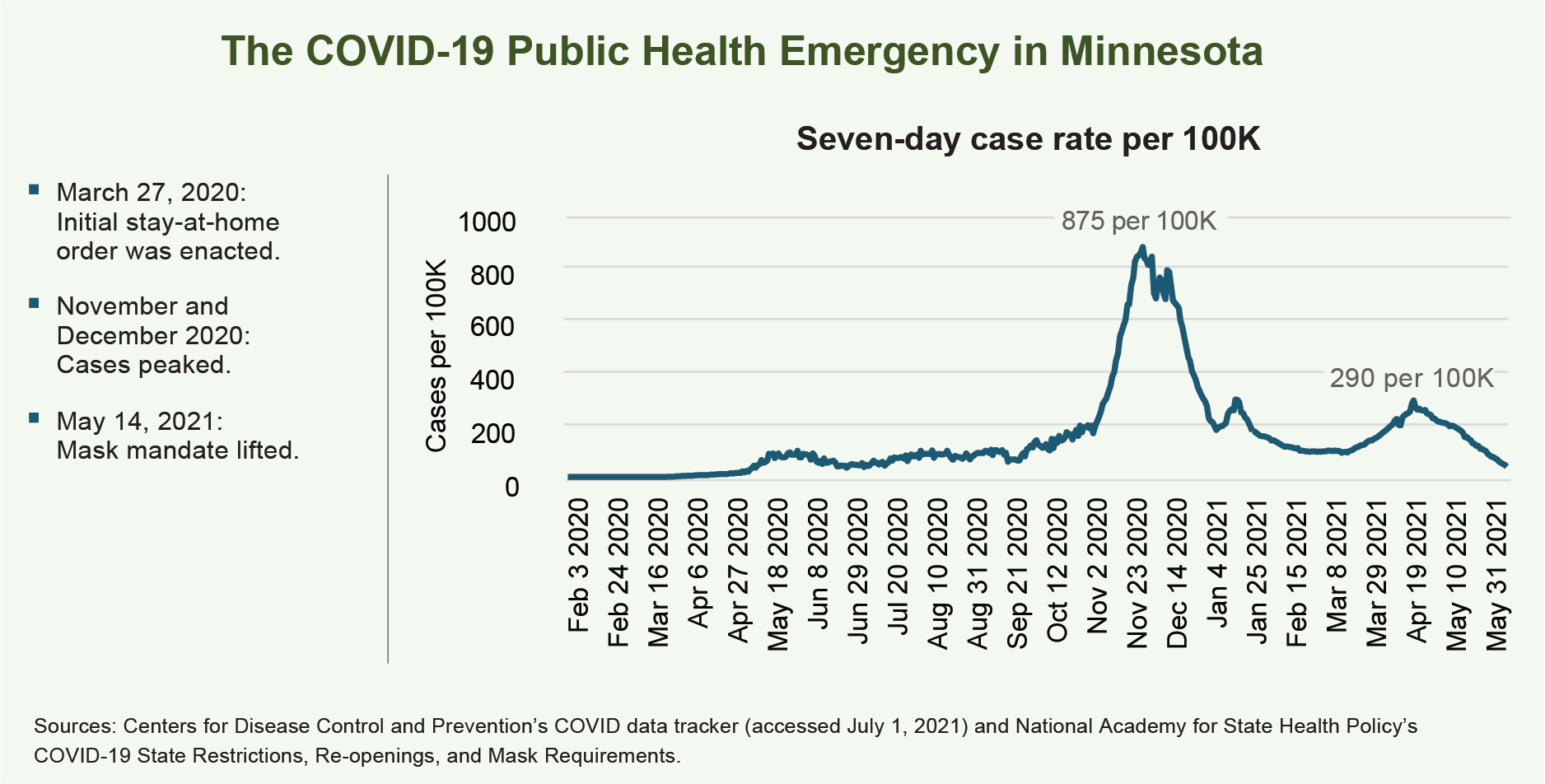Improving Medication Adherence Through Telehealth in Minnesota
WISEWOMAN Innovation Spotlight

Minnesota’s WISEWOMAN program has an innovative approach that aims to identify women with hypertension and connect them to pharmacists through telehealth for medication therapy management. Minnesota began implementation at the beginning of the COVID public health emergency in 2020. Figure 1 displays COVID case rates and timing of public health protective measures as important context that influenced the recipient’s program implementation progress.
- 605 women served, including 377 with a complete high blood pressure screening
- 96% of women identify as Hispanic, Black or African American, Asian or Pacific Islander, American Indian or Alaska Native, or multiracial
- 23% of women had hypertension at baseline screening
Source: Mathematica’s analysis of minimum data elements for women with a complete or high blood pressure screening in Years 1 and 2 (September 2018 to September 2020).
Notes: The national WISEWOMAN program defines hypertension as having an average systolic blood pressure of 140 mm Hg or higher, having an average diastolic blood pressure of 90 mm Hg or higher, or taking medication for high blood pressure.
How It Works
Minnesota partnered with Minnesota Community Care (MCC), a Federally Qualified Health Center, to implement telehealth medication therapy management (MTM) at one of its clinics.*
Through this work, women with hypertension will receive a blood pressure cuff to conduct self-readings and attend virtual appointments with a pharmacist and clinical provider to manage and improve their health conditions. As of April 2021, Minnesota and MCC were still laying the groundwork for the telehealth MTM program because of delays caused by staff changes and the COVID-19 public health emergency (PHE) that began in March 2020 (see Key Partners box).
*MTM is an evidence-based lifestyle program that includes medication therapy review; a personal medication record; a medication-related action plan, intervention or referral; and documentation and follow-up. For more information, see https://www.cdc.gov/dhdsp/pubs/guides/best-practices/pharmacist-mtm.htm.
Telehealth really isn’t being used to manage chronic diseases. And we are hoping to prove this [is] a cost-effective model but also that it really works for people that are underserved, that it’s a way to reach them, keep them engaged, that will both provide better health outcomes [and] lower costs overall, because then you’re not seeing [emergency room] visits.
Achievements to Date
Identified and onboarded an MCC clinic. Minnesota worked with the MCC system to identify a clinic for this initiative and began onboarding clinical staff. Its goal was to begin implementation in early summer 2021 and to enroll 30 to 50 women in the program within the first year of implementation. Clinical staff who will be involved include a lead physician, a pharmacist, and pharmacy residents.
Worked closely with clinical staff to develop a protocol for telehealth MTM. Minnesota met regularly with clinic staff to develop a protocol for the telehealth MTM. In addition, Minnesota program staff researched similar programs to identify best practices and apply them to this project.
Figure 1. The COVID-19 Public Health Emergency in Minnesota, February 2020 to May 2021

This graph titled The COVID-19 Public Health Emergency in Minnesota, charts the seven-day case rate per 100 thousand people, February 3, 2020, through May 31, 2021. The case rate remained close to zero from February 3 to April 27, 2020. An initial stay at home order was enacted on March 27. Case rates began rising after April 27, remaining at around 100 per 100 thousand until October when they began climbing sharply. Cases peaked in November and December at around 875, then dropped just as sharply through March 2021. Case rates climbed again to 290 in April, then dropped off to below 100 by May 31. Mask mandates were lifted May 14. Sources: Centers for Disease Control and Prevention’s COVID data tracker (accessed July 1, 2021) and National Academy for State Health Policy’s COVID-19 State Restrictions, Re-openings, and Mask Requirements.
Related Resources
CDC
References
- Centers for Disease Control and Prevention. COVID Data Tracker. Atlanta, GA: U.S. Department of Health and Human Services, CDC. Accessed July 1, 2021.
- National Academy for State Health Policy. 2020 COVID-19 State Restrictions, Re-openings, and Mask Requirements. Accessed July 1, 2021.

